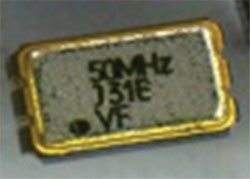
In many electronic assemblies today, thermal mismatch between the printed circuit board (PCB) and the ceramic components causes micro cracks in the solder joints. Several factors contribute to these cracks, notably component size, temperature variation, PCB material and solder material. A common result of these cracks is intermittent failures during use. The failures are easy to detect, but hard to repeat. In commercial applications, we have all experienced this when a cell phone call is dropped, there is a skip in a YouTube video, or an Internet application is temporarily interrupted. The impacts of these interruptions are usually trivial. In military applications, a missile loses its location or target, a soldier's tracking device fails (leaving him temporarily "lost" or worse, not identified as "friendly") or radio communication stops. In these applications, intermittent failures can be life threatening.
In the electronic components market, the standard package for an oscillator device is a ceramic surface-mount (SMT) 7 × 5 mm, 4 or 6 pin package. There are tens of millions of these devices sold every year. In the commercial market, where temperature variations are limited to -40° to 85°C, these oscillators are used in every type of application from SONET to LTE to test equipment. Their universal availability and small size make them ideal for most applications.
In military applications, where temperature extremes are much more demanding (-55° to 125°C), the 7 × 5 mm package is "too big." It seems crazy to think a part the size of the word "big" on this page is actually too big for an application. The calculations are complicated, but the reason is simple; over these temperatures, the PCB flexes more than the ceramic package. The weakest part of the assembly is the solder joint. To relieve the pressure of the stress, micro cracks form on the joint. If there is enough flex and enough cracking, the electrical connection in the joint is "opened" and, for a moment or longer, the device stops functioning. Once the temperature is reduced, the PCB returns to a normal state, the micro cracks fill in and the device begins working again.

Figure 1 Gull wing package (a) and J-lead package (b).
Designers of military-grade systems are well aware of this phenomenon and choose to design using larger packages (14 × 9 mm or greater) with leads on them. The leads "flex," allowing the PCB to move while the more rigid package remains stiff. In applications where a smaller component size is required, manufacturers have been challenged to create new package solutions. Since 7 × 5 mm packages are not available with leads, one accepted solution is to braze or weld leads onto the package. The parts are manufactured using the standard 7 × 5 mm assembly process and then have the leads attached using a brazing process (see Figure 1). The leads are added one at a time and the process is time consuming and tedious. It is also expensive, adding significant cost to the devices. However, it works to relieve the thermal "mismatch" between the PCB and ceramic package.
The Valpey Fisher VFH3225 miniature hi-rel/COTS oscillator represents a significant change for designers of military systems. It takes advantage of the latest package technology, a ceramic SMT 3.2 × 2.5 mm 4 pin package (see Figure 2). At just one quarter the size of the 7 × 5 mm package, or the size of the "b" in the word big, it is small enough that the thermal mismatch between PCB and ceramic is not significant. In other words, the PCB does not flex enough to cause significant stress on the solder joints to crack them. There is no need to add costly leads and designers are no longer restricted to using the larger packages with leads on them.

Figure 2 Valpey Fisher VFH3225 package compared to traditional 7 × 5 mm package.
In addition to solving the thermal mismatch problem, the VFH3225 is the only military temperature range oscillator available that operates up to 160 MHz while maintaining a temperature stability of 50 ppm. With supply voltages of 3.3, 2.5 and 1.8 V, a low power consumption of 12 mW and available Group A, B or C testing, the VFH3225 is a good fit for applications where the environmental conditions are demanding and the choices are limited.
The VFH3225 represents the latest technology achievement from Valpey Fisher. With more than eight decades of innovation in oscillators (including special recognition in 1945 from General Eisenhower for the company's contribution to the war effort), the company continues to design and deliver hi-rel/COTS products that enable a wide range of applications for military communications, munitions and guidance systems.
Valpey Fisher Corp.
Hopkinton, MA
(800) 982-5737
www.valpeyfisher.com
